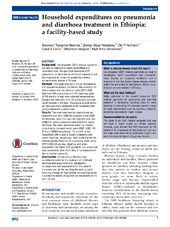| dc.contributor.author | Memirie, Solomon Tessema | en_US |
| dc.contributor.author | Metaferia, Zewdu Sisay | en_US |
| dc.contributor.author | Norheim, Ole Frithjof | en_US |
| dc.contributor.author | Levin, Carol E. | en_US |
| dc.contributor.author | Verguet, Stéphane | en_US |
| dc.contributor.author | Johansson, Kjell Arne | en_US |
| dc.date.accessioned | 2018-03-16T14:00:33Z | |
| dc.date.available | 2018-03-16T14:00:33Z | |
| dc.date.issued | 2017-01-18 | |
| dc.Published | Memirie ST, Metaferia, Norheim OF, Levin CE, Verguet S, Johansson KA. Household expenditures on pneumonia and diarrhea treatment in Ethiopia: a facility-based study. BMJ Global Health. 2017;1:e000166 | eng |
| dc.identifier.issn | 2059-7908 | |
| dc.identifier.uri | https://hdl.handle.net/1956/17525 | |
| dc.description.abstract | Background: Out-of-pocket (OOP) medical payments can lead to catastrophic health expenditure and impoverishment. We quantified household OOP expenditure for treatment of childhood pneumonia and diarrhoea and its impact on poverty for different socioeconomic groups in Ethiopia. Methods: This study employs a mix of retrospective and prospective primary household data collection for direct medical and non-medical costs (2013 USD). Data from 345 pneumonia and 341 diarrhoea cases (0–59 months of age) were collected retrospectively through exit interviews from 35 purposively sampled health facilities in Ethiopia. Prospective 2-week follow-up interviews were conducted at the household level using a structured questionnaire. Results: The mean total medical expenditures per outpatient visit were US$8 for pneumonia and USD 6 for diarrhoea, while the mean for inpatient visits was USD 64 for severe pneumonia and USD 79 for severe diarrhoea. The mean associated direct non-medical costs (mainly transport costs) were USD 2, USD 2, USD 13 and USD 20 respectively. 7% and 6% of the households with a case of severe pneumonia and severe diarrhoea, respectively, were pushed below the extreme poverty threshold of purchasing power parity (PPP) USD 1.25 per day. Wealthier and urban households had higher OOP payments, but poorer and rural households were more likely to be impoverished due to medical payments. Conclusions: Households in Ethiopia incur considerable costs for the treatment of childhood diarrhoea and pneumonia with catastrophic consequences and impoverishment. The present circumstances call for revisiting the existing health financing strategy for high-priority services that places a substantial burden of payment on households at the point of care. | en_US |
| dc.language.iso | eng | eng |
| dc.publisher | BMJ | eng |
| dc.relation.ispartof | <a href="http://hdl.handle.net/1956/15289" target="_blank">Scale-up of high impact maternal and child health interventions in Ethiopia: equity, cost and cost-effectiveness analyses</a> | |
| dc.rights | Attribution CC BY | eng |
| dc.rights.uri | http://creativecommons.org/licenses/by/4.0 | eng |
| dc.title | Household expenditures on pneumonia and diarrhea treatment in Ethiopia: a facility-based study | en_US |
| dc.type | Peer reviewed | |
| dc.type | Journal article | |
| dc.date.updated | 2018-01-09T12:16:15Z | |
| dc.description.version | publishedVersion | en_US |
| dc.rights.holder | Copyright 2017 The Author(s) | |
| dc.identifier.doi | https://doi.org/10.1136/bmjgh-2016-000166 | |
| dc.identifier.cristin | 1536927 | |
| dc.source.journal | BMJ Global Health | |

